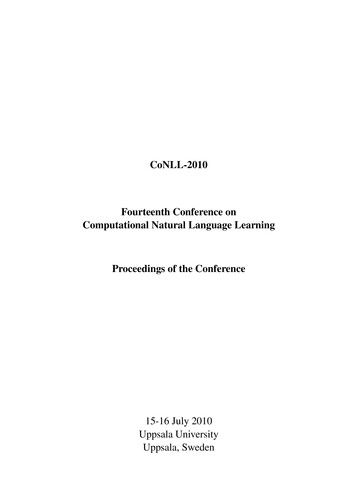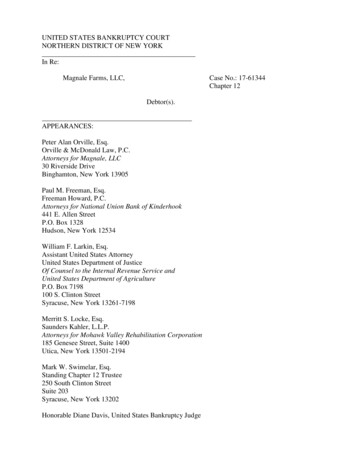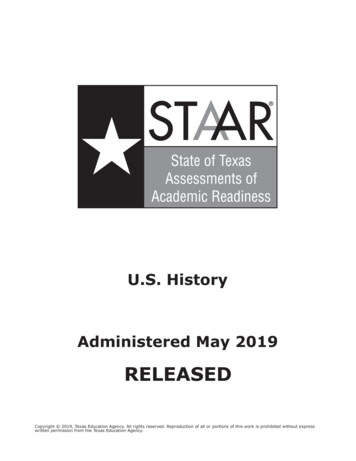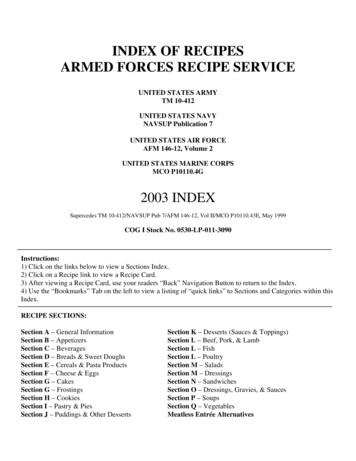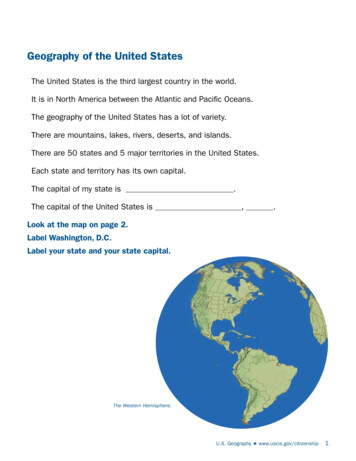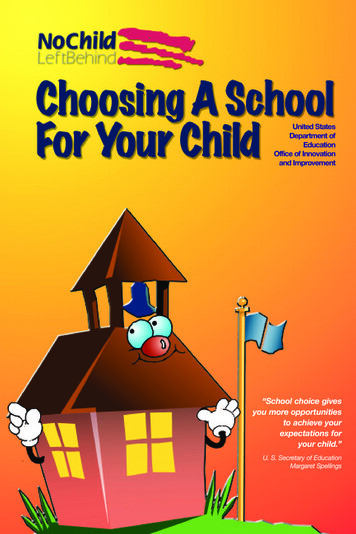
Transcription
United StatesDepartment ofEducationOffice of Innovationand Improvement“School choice givesyou more opportunitiesto achieve yourexpectations foryour child.”U. S. Secretary of EducationMargaret Spellings
Choosing a SchoolFor Your ChildOffice of Innovation and ImprovementUnited States Department of Education
U.S. Department of EducationMargaret SpellingsSecretaryOffice of Innovation and ImprovementMorgan S. BrownAssistant Deputy SecretaryOriginal production of this book was led by Jack Klenk, director, Office of Non-PublicEducation, Office of Innovation and Improvement, and Cynthia Hearn Dorfman, formerdirector of Communications, Office of Innovation and Improvement; and funded bythe Office of Parental Options and Information in the Office of Innovation andImprovement, John Fiegel, director, as part of the Parental Information andResource Centers Program.First published March 2005. Revised August 2007.This book is in the public domain. Authorization to reproduce it in whole or in part for educationalpurposes is granted. While permission to reprint this publication is not necessary, the citation shouldbe: U.S. Department of Education, Office of Innovation and Improvement, Choosing a School forYour Child, Washington, D.C., 2007.Listing of materials and resources in this book should not be construed or interpreted as anendorsement by the U.S. Department of Education of any private organization or business listed herein.To obtain copies of this report in English or Spanish,write to: ED Pubs, Education Publications Center, U.S. Department of Education, P.O. Box 1398,Jessup, MD 20794-1398;or fax your request to 301-470-1244;or e-mail your request to: edpubs@inet.ed.gov;or call in your request toll-free: 1-877-433-7827 (1-877-4-ED-PUBS). If 877 service is not yetavailable in your area, call 1-800-872-5327 (1-800-USA-LEARN). Those who use telecommunicationsdevice for the deaf (TDD) or a teletypewriter (TTY), should call 1-877-576-7734;or order online at www.edpubs.org.This book is also available on the Department’s Web site at:http://www.ed.gov/parents/schools/find/chooseOn request, this publication is available in alternate formats, such as Braille, large print or computerdiskette. For more information, please contact the Department’s Alternate Format Center202-260-0852 or 202-260-0818.ii
Contents List of Parent Tips . . . . . . . . . . . . . . . . . . . . . . . . . . . . . . . . . . . . . . . . . . . iv Letter from the Secretary. . . . . . . . . . . . . . . . . . . . . . . . . . . . . . . . . . . . . . v Choosing a School . . . . . . . . . . . . . . . . . . . . . . . . . . . . . . . . . . . . . . . . . . 1 Learn What Choices Are Available to You . . . . . . . . . . . . . . . . . . . . . . . . 2 Four Steps for Selecting the School That Is Right for Your Child. . . . . . 6Step 1. Consider your child and your family. . . . . . . . . . . . . . . . 6Step 2. Gather information about schools. . . . . . . . . . . . . . . . . 10Step 3. Visit and observe schools. . . . . . . . . . . . . . . . . . . . . . . 20Step 4. Apply to the school(s) you choose. . . . . . . . . . . . . . . . 26 Congratulations . . . . . . . . . . . . . . . . . . . . . . . . . . . . . . . . . . . . . . . . . . . . 29 Resources . . . . . . . . . . . . . . . . . . . . . . . . . . . . . . . . . . . . . . . . . . . . . . . . 31 Parent Information Organizations . . . . . . . . . . . . . . . . . . . . . . . . . . . . . . 32 Acknowledgments. . . . . . . . . . . . . . . . . . . . 33 Your Contacts. . . . . . . . . . . . . . . . 34iii
List of Parent Tips Know Your Options Under the No Child Left Behind Actfor Children in Public Schools That Are “In Need of Improvement”. . 9 Check the School District’s Report Card for Public Schools . . . . . . 14 Know Your Options Under the No Child Left Behind Actfor Children in Public Schools That Are Unsafe . . . . . . . . . . . . . . . . 19 10 Things to Look for in a School . . . . . . . . . . . . . . . . . . . . . . . . . . .25 Start Early and Cover All the Steps. . . . . . . . . . . . . . . . . . . . . . . . . . 28 Find Helpful Resources at the U.S. Department of Education’sChoice Web Site . . . . . . . . . . . . . . . . . . . . . . . . . . . . . . . . . . . . . . . . 30iv
Dear Parents,Do you remember when your child was born, how your child quickly wrapped all five fingersaround your one? Your child will continue to grasp your hand throughout childhood and youth.You are your child's first and lifelong teacher. And, as a parent and teacher, you will makeimportant decisions for your child.Some of the most important decisions you will make are about your child's education. Youwant your child's school to meet the same goals of high academic achievement you have set.You may want your child's school to reflect the values of your family and community. In otherwords, you want to choose a school that is a good fit for your child. In an increasing numberof communities in our nation, you now have the ability to do so.This booklet, Choosing a School for Your Child, is a type of "decision tool" that can help younavigate the process of choosing a school. It explains some of the public school choices nowavailable in many communities and covers private school options that may be available as well.It outlines steps that you can follow to help you make a thoughtful choice, and it includes questions that you might want to ask when going through the process.In addition, this booklet highlights new options for your child's education provided in the federal law, the No Child Left Behind Act. The law allows parents whose children are in publicschools that need improvement or are unsafe, to choose other public schools or take advantage of free tutoring or extra educational help.The law also supports the growth of more independent public charter schools and fundssome services for children in private schools. Finally, it mandates states and local school districts to provide a wealth of new information to help you make informed educational choicesfor your child.School choice can help give every child an excellent education. It is amazing what can happenwhen parents get involved. School choice gives you more opportunities to achieve your expectations for your child. Armed with options and information, you can be a powerful advocate foryour child.I offer you Choosing a School for Your Child as a tool with practical information to help youmake informed decisions about your child's education. I wish you success with this challenge.Sincerely,Margaret SpellingsSecretaryU.S. Department of Educationv
For additional resources on choosing a school, you canvisit the U.S. Department of Education’s page for parents athttp://www.ed.gov/parents/landing.jhtmlor the page on school choice athttp://www.ed.gov/nclb/choicevi
Choosing a SchoolParents have a growing array of options in choosing a school, though the extentof the options varies from state to state. The enactment of the landmark No ChildLeft Behind Act of 2001; the rapid growth of the charter school movement; theincreasing number of states enacting scholarship and tax credit programs for students to attend private schools; the expansion of privately funded scholarship programs for low-income children; and the growing acceptance of homeschoolinghave all increased the choices available to families.Parents can exercise choice in many ways. The most common way may be inchoosing where to live based on the public school district or neighborhoodschools. In many areas, parents can choose from neighborhood schools, charterschools or other public schools of choice, or transfer their child to another publicschool (in or out of district). They can also select a private school (religious or secular) or teach their child at home.Choosing a School for Your Child offers step-by-step advice on how to chooseamong the schools available to your child. It identifies important factors you maywant to consider before making a decision. As you and your child visit differentschools, you may want to consider the questions in each section of this booklet.Why Should You Choose Your Child’s School?No one cares more about your child’s welfare than you do. No one else will be morecareful to see that your child is well educated and well treated in school. You knowyour child’s personality, strengths and weaknesses. You know the interests that lightup your child’s eyes. You know the values that your family wants a school to respect.Choosing your child’s school may also make you more confident that she will betaught effectively and treated fairly. Choosing your child’s school carefully is an important way you can help your child achieve all that he can be. This is a head and a heartdecision. Don’t be afraid to heed your own informed and intuitive wisdom.1
Learn What ChoicesAre Available to YouDifferent schools offer alternatives in teaching styles, content, and learningopportunities. This section briefly describes some types of schools you may find.Public SchoolsNeighborhood Public SchoolsMany parents choose to send their children to the public school in their neighborhood, according to an assignment system developed by the school district.Attending a neighborhood public school can make it easy for your child to getto school, to work with classmates on group projects, and to visit friends. Theseschools are often anchors in a community.Other Public SchoolsYou may want to investigate other public schools. In an increasing number ofdistricts, you can choose to send your child to a specialized public school.These schools of choice often emphasize a particular subject or have a specialphilosophy of education. One school might emphasize science, art, or languagestudy. Another might offer a firm code of conduct, a dress code, or a rigoroustraditional academic program.Another may be an alternative school designed to respond to students who areinsufficiently challenged by the regular school program, who are likely to dropout, or who have behavioral or substance abuse problems. These schools, oftensmall, work to make students feel they belong. Some states also offer secondchance schools or clinics for students who have dropped out of regular schoolsand now want to complete their education.2
Charter SchoolsCharter schools are public schools of choice that operate with freedom frommany of the local and state regulations that apply to traditional public schools.Charter schools allow parents, community leaders, educational entrepreneurs,and others the flexibility to innovate, create and provide students with increasededucational options. Charter schools exercise increased autonomy in return forstronger accountability. They are sponsored by designated local, state, or otherorganizations that monitor their quality and integrity while holding them accountable for academic results and fiscal practices. Magnet SchoolsMagnet schools are designed to attract students from diverse social, economic, ethnic, and racial backgrounds by focusing on a specific subject, such as science, technology, or the arts. Some magnet schools require students to take anexam or demonstrate knowledge or skill in the specialty to qualify to go to theschool, while others are open to students who express an interest in that area. Virtual SchoolsInstead of taking classes in a school building, students can receive their education using a computer through a virtual school. Virtual schools have an organized curriculum. Depending on the state and district, students can take the fullcurriculum or individual classes. Some school districts have used these onlineschools to offer classes that will help students learn at their own pace. Virtualeducation is sometimes used in remote areas for specialized or advancedcourses that are not available in the immediate area. This type of studying is alsocalled “distance learning.” Advanced Placement andInternational Baccalaureate ProgramsAdvanced Placement (AP) courses offer rigorous content, and at the end of acourse students can take the national Advanced Placement exam. If they scorewell on the exam, many colleges and universities will grant college credit forcompleting the course. The International Baccalaureate (IB) is a program of rigorous academic courses. Students who graduate from the program receive an3
International Baccalaureate diploma that is recognized by colleges and universities throughout the world. Other students may choose not to take the full IB curriculum but pursue certificates in individual areas. Elementary and middle schoolsmay also offer components of the IB program.Nonpublic SchoolsIn addition to public schools, there may be a variety of religious and other nonpublic schools available in your area or boarding schools away from home. Theseschools of choice have been part of the fabric of American education since colonial days. These schools have been established to meet the demand to supportparents’ differing beliefs about how their children should be educated.Religious Private SchoolsThe majority of nonpublic schools are religious. Many are affiliated with adenomination, local church, or religious faith such as Roman Catholic,Protestant, Greek Orthodox, Jewish, Muslim, Buddhist, or other.Secular Private SchoolsThere are also many nonpublic schools without a religious identity or affiliation. Someof these private schools are preparatory schools designed to prepare students forcollege. These schools often have a traditional or elite reputation and a long history.Other schools are based on a particular educational philosophy or approach tolearning, such as Montessori or Waldorf schools; have a special education focus,such as schools for the deaf or blind; or have been established for families and children who may be dissatisfied with various aspects of conventional schools.Home SchoolsHomeschooling is an option for a growing number of parents. Some parents prepare their own materials and design their own programs of study, while others usematerials produced by companies specializing in homeschool materials. Sometake advantage of virtual school programs or other educational resources availableon the Internet. Of course, exercising this option may require major changes inhow your family lives. Teaching your children at home is an ambitious undertaking,requiring time, planning, creativity, and commitment. Be sure to check with yourstate because different states have different requirements for homeschooling.4
Selecting a Schoolfor Your ChildHow do you pick the best school for your child? Whether you are choosing apublic or private school or homeschooling, whether or not you are paying tuition,careful planning is a must. The following sections have questions for you to consider, with workspace for you to write down your thoughts, as you go throughthe process of choosing a school for your child. Remember, you are looking fora school that will make the educational experience for your child and you asrewarding as possible.Write Down Five Things That Are Most Important to YouYou may wish to write down five things that are most important to you asyou consider the choice of a school. As you go through the selectionprocess, you may want to add to and revise your list.1. . . . . . . . . . . . . . . . . . . . . . . . . . . . . . . . . . . . . . . . . . . . . . . . . . . . . . . . . .2. . . . . . . . . . . . . . . . . . . . . . . . . . . . . . . . . . . . . . . . . . . . . . . . . . . . . . . . . .3. . . . . . . . . . . . . . . . . . . . . . . . . . . . . . . . . . . . . . . . . . . . . . . . . . . . . . . . . .4. . . . . . . . . . . . . . . . . . . . . . . . . . . . . . . . . . . . . . . . . . . . . . . . . . . . . . . . . .5. . . . . . . . . . . . . . . . . . . . . . . . . . . . . . . . . . . . . . . . . . . . . . . . . . . . . . . . . .5
Four Steps for Selecting the SchoolThat Is Right for Your ChildStep1Consideryour child& yourfamily.Start your search for the best school by thinking aboutwhat you want a school to do for your child. Perhaps yourchild has special language or education needs. Keepthese in mind. After all, you know your son or daughterbetter than anyone else does.6
Your Child’s NeedsDoes your child need a morestructured environment?Does your child need a lessstructured environment?NOTEPADRead thequestions andjot down somenotes to helpyou with yourdecisions.Does your child need morechallenging work?Does your child need more individualattention?Does your child generally need extrahelp or more time to complete anassignment?Does your child have any speciallearning needs?Does your child need an environmentthat fosters creativity?Does your child need an Englishlanguage acquisition program?Your Child’s Learning StyleDoes your child learn best by seeinghow things work?Does your child learn best by readingabout how something works?Does your child learn bestby listening?Does your child like to participatein discussions?Does your child like to learn throughphysical activity?Is your child logical or mathematical?Is your child musical or artistic?Does your child like to learnin groups?Does your child like to work alone?7
Location of SchoolDo you want your child to go toa school within walking distance of yourhome?Can your child’s talents be nurtured outside your neighborhood?How far are you willing to have your childbused?How far are you willing to drive your childto school?Does your child want to be in a schoolwith his or her friends?Do you want your child to go to a schoolnear your after-school care? Near whereyou work? Near a close relative?Does your child have any special transportation needs that must be consideredin choosing a school?8NOTEPADRead thequestions andjot down somenotes to helpyou with yourdecisions.
Parent Tip:Know Your Options Under theNo Child Left Behind Act for Childrenin Public Schools That Are “In Needof Improvement”Parents of children in public schoolsdesignated as “in need of improvement”can choose another public school orsupplemental educational services(free tutoring).If your child's public school receives federal Title I funds, it must let youknow how well the students in the school are learning. The school districtmust contact you if the school does not meet the academic standards setby the state for two consecutive years. You can find out how well yourschool is doing by looking at the school's report card.If your child's school has been identified by the state as in need ofimprovement, the school district must give you the choice of keeping yourchild in that school or sending him or her to another public school.If your child attends a school that has needed improvement for more thana year, your school district is required to give you a list of organizations andinstitutions that provide tutoring or extra help outside of the regular schoolday. This extra help is called "supplemental educational services." If yourchild is eligible for this help, and your income is low, the school district maypay for these extra services. Such services may include before- and afterschool tutoring in reading, other language arts, or math.If you have not heard from your public school about whether the school is“in need of improvement” and whether your child qualifies to receive supplemental educational services, contact the school or the school districtand ask for the person(s) in charge of choice and supplemental servicesprograms. You can also go to your state department of education's Website for a list of schools in need of improvement and approved supplemental educational services providers. If you have difficulty finding these lists,call the U.S. Department of Education at 1-888-814-6252 for help inreaching your state contact, or go to the U.S. Department of Education'sWeb site at http://www.ed.gov/about/contacts/state/index.html for a listof contacts in your state.9
Four Steps for Selecting the SchoolThat Is Right for Your ChildStep2GatherInformationAboutSchoolsIf you were looking to buy a car, vacuum cleaner, orrefrigerator, you could talk to friends and family and findinformation on the Internet, in consumer magazines, or inother published resources. Similarly, when investigatingschools, you may also have to make phone calls, collectwritten material from different schools and look for reports inyour local paper to get the information you need. You cancheck public school report cards (see Parent Tip) and go toparent fairs and school open houses.You can find reliable schoolinformation online on sites suchas www.greatschools.netand www.schoolmatters.org,as well as other sites listed in the Resourcessection of this booklet. The hard work will beworth your while if you find a school that10brings out the best in your child.
Along with the schools’ curricula andphilosophy, you will want to knowabout school policies and services.Parents may also wish to consider theafter-school programs a school offers,for example, sports, clubs, tutoring, oracademic enrichment. Some schoolshave after-school activities funded bythe U.S. Department of Education’s21st Century Community LearningCenters program. These centers provide educational activities outside of theregular school hours—before and afterschool or during summer vacation—that complement what is taught inschool. You may also want to ask if theschool has supplemental educationalservices, including free tutoring, that areoffered outside of the regular schoolhours under No Child Left Behind.NOTEPADRead thequestions andjot down somenotes to helpyou with yourdecisions.CurriculumDoes the school have a strong program of core academic subjects suchas English, history, mathematics, science, arts, and foreign languages?What courses does the school offer inaddition to the core subjects?What evidence is there that theschool is effectively teaching studentsto read?Does the school have a special focusor theme for the curriculum?Does the school offer challengingcourses such as Advanced Placement,International Baccalaureate, and highschool honors courses?11
Does the school provide enrichmentopportunities for all students? For giftedstudents?Does the school have extracurricularactivities that support what is taught?Is there an effective English languageacquisition program for children whoneed it?If your child has special learning needs,does the school have a curriculum andthe necessary supports to appropriatelyaccommodate those needs?Approach to LearningDoes the school have a particularapproach to teaching and learning (e.g.,group projects, individual performance,frequent testing)?If yes, do you think your child will enjoyand learn from this approach?Does the school do all it can to makesure each child learns? Does it provideopportunities for children to get extrahelp when they need it?Is the school staff able to communicatein the language that your child understands?Are children with limited English language skills, learning disabilities, or otherspecial needs learning and performingwell on tests?What is the homework policy? Does itmatch your expectations for how muchhomework your child should do?Do you want your child to go to a singlesex (all-boy or all-girl) school, or a coeducational school?How large are the classes?12NOTEPADRead thequestions andjot down somenotes to helpyou with yourdecisions.
Academic PerformanceHow do the school’s test scores compare to those of other schools?(Check the school’s report card if it isa public school or ask for informationfrom the school if it is a privateschool. See “Parent Tip” on schoolreport cards.)In the past few years, have testscores risen or declined? How doesthe school explain the rise or decline?How well have children similar toyours performed on these tests?How do students moving on to thenext level of schooling perform in theirnew schools?How many students leave the schoolbefore completing the last grade?What special achievements or recognition has the school received?Behavior PolicyWhat does the school do to helpdevelop character and citizenship?What is the discipline policy? Howdoes the school handle students whomisbehave?Are teachers fair in their responses tostudents? Does the school have aprogram and supports to prevent andaddress behavior problems?Are students allowed to leave schoolby themselves?What measures has the school takento ensure safety? What securitymeasures are in place?13
Parent Tip:Check the School District’sReport Card for Public SchoolsNo Child Left Behind requires school districtsthat receive federal funds to provide a reportcard on how its schools and the school districtare doing. For individual schools, the reportcard includes whether the school has beenidentified for school improvement and how itsstudents performed on state tests compared toother students in the school district and the state.For the district, the report includes the combined test scores of thestudents at all the district’s schools.Public school report cards should include:Students’ scores on state tests, broken out by student subgroups;How many students performed at the “basic,” “proficient,” and“advanced” levels on the tests;Graduation rates;Numbers and names of schools that need to improve in the district;Qualifications of teachers; andPercentage of students who were not tested.14
Behavior Policy (continued)What is the policy on schoolabsences? How does the schoolencourage daily attendance?Do school personnel call parentswhen students are absent?Does the school have a drug andalcohol abuse prevention program?Does the school have a dress code?Do students wear uniforms?SafetyIs the school safe?How does the school prevent andhandle problems with drugs, alcohol,and tobacco?How does the school prevent andhandle violence, bullying, harassment,and other forms of abusive behavior?What measures does the school taketo ensure safety? What securitymeasures are in place?What is the school’s relationship withthe local police?Is there a police officer on duty duringschool hours and for extracurricularactivities?What information is available on serious crime in the school?What information is available on students bringing weapons to school?Does the school have an emergencyplan for local and national emergencies?What does the school do to ensurethat parents and all school administrators know the emergency plan?15
Are there drills?How does the school notify parentsabout emergency closings? Howdoes the school communicate withparents in other languages?Special OfferingsWhat extracurricular activities doesthe school offer after school or onweekends?Do all students have the opportunity toparticipate in extracurricular activities?What interscholastic activities areavailable to students?What intramural activities are availableto students?What activities receive the most attention and resources?Are there school and studentpublications?Does the school sponsor field trips?Are they available to all students?Are publications for parents availablein other languages?Facilities and ServicesIs there a well-stocked library wherestudents can check out books anddo research? Are reading materialsavailable in other languages?Is there interlibrary loan?Is time provided in the day for students to go to the library?Do students have access to computers and to the Internet in the classroom and library?Is use of the Internet monitored?16NOTEPADRead thequestions andjot down somenotes to helpyou with yourdecisions.
Is there an auditorium or a largeroom for school assemblies?Is a school nurse on duty daily?Is there a cafeteria, and does theschool offer a nutritionally well-balanced lunch program? Breakfastprogram?Is supervised before- and afterschool care offered?Are there tutoring programs?Are counseling services available tostudents?Is the school accessible to childrenwith mobility limitations?Admissions Procedures forPublic Schools of Choice andPrivate SchoolsIs there an application process?What is the application deadline?Is anything else required in the application (test scores, interview, recommendations, application fees, etc.)?Are test scores required for admission? What are the ranges of scoresfor admitted students?Do admissions requirements include aportfolio, an audition or statement ofinterest?Are there any other admissionsrequirements?Are admissions requirements published in languages other thanEnglish?17
Additional Questions AboutPrivate SchoolsWhat is the tuition?Is there a payment plan?Is there a sliding scale for tuition,based on parish, church affiliation, orfamily income?What are the other fees and expenses(room and board, uniforms, books,transportation, lab and computerfees, activity fees)?What scholarships and loans areavailable?Are students or their parents requiredto be of a particular faith?Does the school have a policy on student participation in religious instruction and worship?Does the school close for religiousand federal holidays?Does the school have the sameschedule as the local public school?Additional Questions AboutHome SchoolsHave you identified curriculum materials for your child, and how muchthey will cost?Is there a suitable place for yourchild’s study and instruction?Do you, your spouse, or anotherhomeschooling parent have adequate free time to be available toyour homeschooling child?18NOTEPADRead thequestions andjot down somenotes to helpyou with yourdecisions.
Do other families in your area homeschool their children?Is there a support group of homeschoolers near you?If you are interested in some outsideinstructional support, have youchecked your local library, parksdepartment, scouting organizations,public and private schools, and similar resources
No one cares more about your child's welfare than you do. No one else will be more careful to see that your child is well educated and well treated in school. You know your child's personality, strengths and weaknesses. You know the interests that light up your child's eyes. You know the values that your family wants a school to respect.







